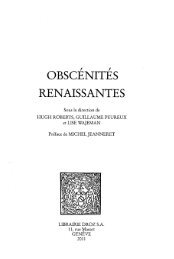Download (3398Kb) - ePrints Soton - University of Southampton
Download (3398Kb) - ePrints Soton - University of Southampton
Download (3398Kb) - ePrints Soton - University of Southampton
You also want an ePaper? Increase the reach of your titles
YUMPU automatically turns print PDFs into web optimized ePapers that Google loves.
(Hymenaster membranaceus Thomson). The two species <strong>of</strong> the family Myxasteridae<br />
analyzed in this study were grouped in the cluster B.<br />
After comparing the depth distribution <strong>of</strong> the species with the results obtained<br />
by the cluster analysis, a possible pattern <strong>of</strong> zonation and reproductive features was<br />
found considering the adult size, egg size, fecundity and Gonad Index as follows:<br />
a) A first zone is found, which coincides with the zonation established by Howell<br />
et al. (2002). In this first zone situated in the upper slope from 150-700 m depth, large<br />
species with shallow-water distribution, small egg size, high fecundity and<br />
planktotrophic development are found.<br />
b) Only two species with large adult size, low G.I., large egg size and low<br />
fecundity indicating lecithotrophic development are found from around 800 m depth.<br />
c) From 700 to 1100 m depth only species having small adult size, large egg size<br />
with low fecundity and low G.I. are found, the totality <strong>of</strong> this species are included in<br />
the cluster B recognized by the cluster analysis, this zone coincides with the mid<br />
bathyal zone proposed by Howell et al. (2002).<br />
d) A zone <strong>of</strong> mixed reproductive features on the species was found from ~1100<br />
to ~3000 m. In this zone there are species belonging to the three clusters found in the<br />
cluster analysis. Therefore, there are species having large adult size, low G.I., large<br />
egg size and low fecundity, there are also species with small adult size, low G.I, large<br />
egg size and low fecundity. Finally in this zone are also found species which have<br />
large adult size, large egg size, low fecundity, and low Gonad Index. This pattern<br />
appears to support the existence <strong>of</strong> a zone <strong>of</strong> transition from 1700-3300 m proposed<br />
by Howell et al. (2002) consisting in part <strong>of</strong> bathyal species whose ranges extend<br />
down into this zone and in part from abyssal species whose ranges extend up into this<br />
zone, with few species confined to the transition zone.<br />
81
















